How to Play
Objective
Earn the most coins from selling crops.
Setup
The third bean field cards are set to the side and will be used later. All of the other cards are shuffled and five cards are dealt to each player. Players pick up their cards but can not rearrange them. The cards need to stay in the order that they were dealt to the player. The rest of the bean cards are placed face down and form the draw pile. The player to the left of the dealer goes first.
In the variations section of the rulebook there are also guidelines on what cards should be removed from the game in order to shorten the length of the game. Based on the number of players the rules recommend the following:
- 3 players: Remove the Cocoa Bean cards from the game. Each player also start the game with the 3rd bean field card. The game also ends when the draw deck is exhausted twice.
- 4-5 players: Remove the Coffee Bean cards.
- 6-7 players: Remove the Cocoa Bean and Garden Bean cards. The first player is dealt three cards, the second player four cards, the third player five cards, and the rest of the players receive six cards. When drawing cards each player will draw four cards instead of three. The 3rd bean field cards also only cost two gold coins instead of three.
Layout of a Card
Before getting to the rules you should familiarize yourself with the format of the cards. Each card will have a number printed in the picture portion of the card. This number indicates how many of that type of card are present in the deck. Along the bottom of the card is a row of coins with numbers printed below. This is the beanometer and indicates how many coins you will receive for selling the crops of that type of bean. The numbers below the coins indicate how many cards of that type have to be planted in a field in order to sell them for the number of coins pictured.
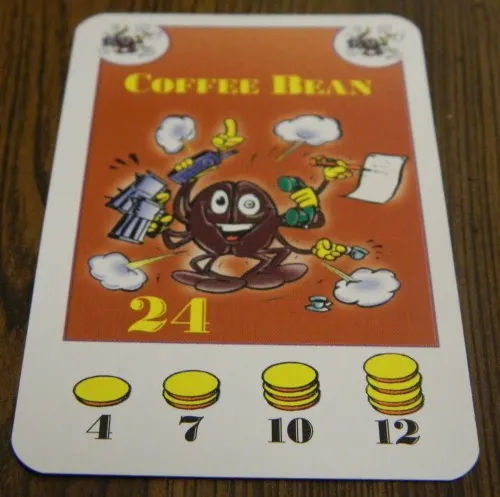
Here is a coffee bean card. The yellow 24 indicates that there are 24 coffee bean cards in the deck. The numbers along the bottom indicate how many cards you need to earn certain amounts of coins. For coffee beans you need four cards for one coin, seven for two coins, ten for three coins and twelve for four coins.
Turn Order
During a player’s turn they will take four actions as follows:
- Plant bean cards
- Draw, trade and donate bean cards
- Plant traded and donated bean cards
- Draw new bean cards
Planting Bean Cards
To begin each turn the current player must plant the first card from their hand. Players cannot change the order of their cards at any time during the game since that would alter this step. To begin the game each player has two bean fields. The player can play their next bean card on an empty bean field or on a field with the same type of beans planted. If both fields are filled and the card doesn’t match either field, the player is forced to sell one of the fields in order to make room for the next card (see “Harvesting Beans” section).
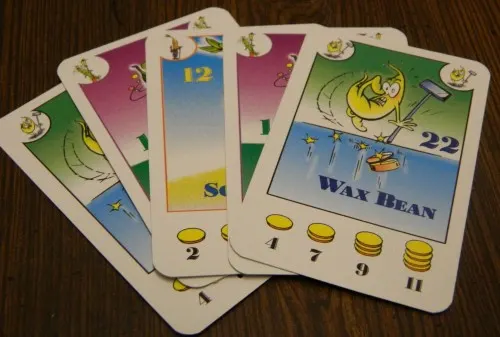
The current player will have to plant the wax bean this turn. The player has the option of playing the green bean.
The player then has the option to plant the second card in their hand. The player can chose not to plant the card if they don’t want to.
Draw, Trade and Donate Bean Cards
After the player has planted one or two cards they draw the top two cards from the draw deck and turn them face up. The player now gets to choose what they want to do with these two cards. They can keep both cards, one card, or neither card. The cards they chose to keep are set aside face up on the table for the next step. Players can also choose to trade or donate either or both cards to other players and may also trade/donate cards from their hand. Trading/donating must follow a couple rules:
- Only the current player can make trades/donate cards at this time and may only trade/donate with one player at a time.
- All cards that are traded or donated will stay on the table and will not be put into any player’s hand.
- The current player can trade/donate as many cards as they want, to as many players as they want.
- No cards are removed from a players hand until a trade/donation is confirmed by both players to prevent the card order from being mixed up.
- Cards that are already planted can never be traded or donated.
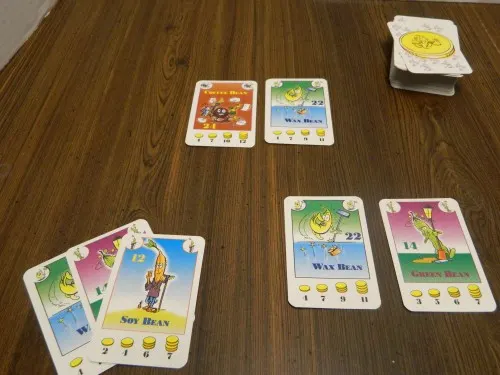
The player drew a wax bean and a coffee bean. The player would likely want to keep the wax bean and try to trade/donate the coffee bean.
Trade Cards
Players can trade any combination of cards from the face up cards that were drawn and cards currently in their hand. They may trade the cards for any card(s) in another players hand. Trades can include any number of cards and both sides do not have to trade the same number of cards. All cards that are traded are set aside on the table to be planted in the next step.
Donating Cards
If a player is unable to trade a card they may be forced into donating a card instead of being stuck with it. The reason a player may be willing to donate a card is to get rid of a card that would force them to sell a bean field that they otherwise would have liked to have kept to build up more coins. A player can offer up the face up cards or any cards from their hand for donations. If a player accepts the donation that player takes the card and places it off to the side to be planted in the next step. Donations don’t have to be accepted and if they aren’t the current player will be stuck with the cards.
Plant Traded and Donated Bean Cards
After all trading is completed all players who have cards set to the side through trades/donations will have to plant these cards. Each player gets to chose the order that they would like to plant the cards but all of the cards must be planted. If these cards force a sale since both fields are filled, the player will need to sell the beans in one of the fields (see “Harvesting Beans” section).
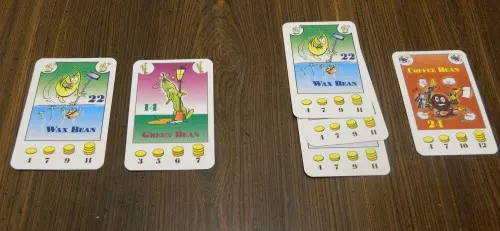
Through trades the current player acquired three wax beans and one coffee bean. The player gets to choose the order in which they would like to plant the cards. The current player could either plant the coffee bean first getting rid of the green bean or they could play the three wax beans and then sell the wax beans when the coffee bean is planted.
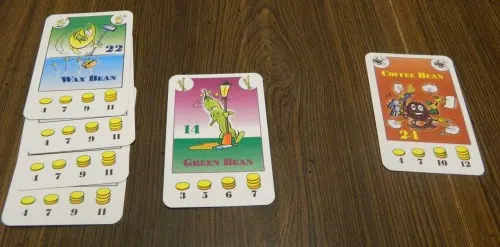
The current player chose to plant the three wax beans first. This will force the player to harvest the wax bean field when they plant the coffee bean.
Draw New Bean Cards
The current player draws three cards from the draw deck. The player draws one card at a time making sure they place the card at the back of their hand. When the draw deck is exhausted, the discarded cards are shuffled and become the new draw deck.
Harvesting Beans
Players may harvest beans at any time even if it is not their turn. When harvesting beans the player receives coins based on the number of bean cards in the field. Players flip one of the cards from the field for each coin earned and sets them aside for later. The other beans harvested are discarded. If a player is forced to sell a bean field before it has earned any points, the player will receive zero coins for that field. Players may NOT sell fields containing only one bean unless they are forced to sell a field and both fields only contain one bean.In this case the player can choose which field to sell.
Buying A Third Bean Field
At any time each player has the opportunity to buy one additional bean field allowing them to plant three different types of beans at the same time. Players must give up three of their coins in order to purchase the third field. The player then takes a third bean field card to indicate that they can now plant in three different fields.
End of Game
When the draw deck is exhausted for the third time the game ends. If this occurs during the second step of the current player’s turn, they complete the rest of their turn until the end of step three. Players sell all of their beans currently planted and receive the corresponding number of coins. Players then count up their coins. Whoever has the most coins will win the game. If there is a tie, whoever had the most cards in their hand at the end of the game will break the tie.
Review
Uwe Rosenberg has had several hit board games in his career which include Agricola, Le Havre, Caverna and Patchwork. One of his first games was Bohnanza which is a beloved game by itself. Despite having no interest in bean farming, Bohnanza is an easy to play card game that has a surprising amount of strategy to it.
A Deceptively Simple Game
Generally my favorite types of games are the games that have a moderate amount of strategy but don’t take hours to learn how to play. This describes Bohnanza quite well. The rules for Bohnanza are eight pages long which take a while to read through but the rules are well written. At first Bohnanza takes a while to fully understand but it is the type of game that becomes easy to play once you fully understand what you are doing. The hardest part of the whole game is probably remembering not to mix up the cards in your hand. This rule makes it pretty easy for players to cheat accidentally or on purpose. The rule is necessary though since it forces players to have to trade with one another which is one of the best parts of the game.
The game has a decent amount of strategy to it even though the mechanics are really simple. The game also relies heavily on luck but you can try to turn things in your favor by planning out what you want to do with your cards based on what you already have planted and what cards are coming up soon in your hand. If there is a card that is going to mess with your strategy you should try your hardest to get rid of it even if you have to donate it to another player for free. Unless you are the luckiest person in the world you will eventually encounter a situation where you need to get rid of cards so hand management is really important for success in the game.
I’ll Trade You A Coffee Bean For A Blue Bean
The real strategy in the game comes from the trading/donating. I love the idea that Bohnanza forces you to trade with other players. While trading is allowed in a lot of games, trading rarely happens since players are usually too stubborn that they will only trade if they are getting a better value than the other player. If you don’t trade with other players in Bohnanza you have no chance of winning unless you are very very lucky. This is not going to happen so the only way you are going to score points is to work with the other players and help one another.
The only problem with the game relying so heavily on trading/donating is that if the players aren’t willing to compromise the game will get dull pretty quickly. If you have a player that is never willing to “lose” in a trade the game is going to suffer. All of the players need to realize that no one is going to win every trade. Players need to be willing to lose some value in a trade so both players benefit from the trade. The good thing about Bohnanza is that in most situations both players are going to win in a trade. Most trades result in both players earning a point so neither player feels cheated in the trade since both benefited while the players not involved in the trade got nothing.
What I like about the game is that you can come up with such creative trades between two players. In our game we had people giving up additional cards just so someone would take a card from them that they really wanted to get rid of. There were also several multiple card trades. If all of the players are willing to work together the game is much more enjoyable and engaging.
The Game Could Be Quicker
If I had one major complaint about Bohnanza it would have to be the length of the game. The game lists the length at around 45 minutes but I think that is quite optimistic. The game I played lasted quite a bit longer than that and we didn’t even play through all three times through the draw deck. While I really liked the game, the game just took way too long to finish and that kind of hurt the experience.
I think there might have been three main culprits that made the game so long.
First all of the players tried to trade/donate every single card that they didn’t want. Everyone always tried to get an optimal trade and players only backed down slowly which made trades take quite a bit longer than they probably had to. The trading/donating is one of the best parts of the game though so you don’t want to limit it too much but I think we spent too much time on the trades.
The second reason I think the game ran long is that I played with only three players. With more players I think the game would have moved a little quicker since there would have been more people to trade with which would have made trades go quicker. With more players cards would get drawn from the deck quicker as well which would have gotten rid of the cards quicker. I think the game would move faster and be more enjoyable if played with more players. Having too many players might cause the same problem though so you might want to limit the game to 4-6 players.
The last reason why the game probably took longer than expected was that we actually misplayed one of the rules. We ended up forgetting about the rule where you could only harvest a one card bean field if the other bean fields also only had one card. This allowed players to keep their fields in play longer which might have lead to players spending more time trying to make trades which might have extended the game. Even though we ended up playing this rule incorrectly I think the way we played the game might actually be better since I think it would be too difficult to score points following the actual rule.
Other Quick Thoughts
- The artwork for the cards is really well done. The card layout is also well done which makes it easy to find the necessary information on every card quickly.
- The game has some issues with a runaway leader. If one player gets out to a big lead they tend to maintain or even expand their lead. I don’t know exactly why but it seems hard for players to catch up in the game. Part of this is probably due to the third field cards. In my opinion the third bean field cards are huge in the game and are worth every coin. They give you a lot of flexibility which is probably one reason why an early leader can get a big lead since the third bean field will just help them score even more points.
- Like a lot of card games, Bohnanza relies pretty heavily on luck. No matter how good your strategy/trading is, if the cards you draw don’t work for the fields that you are currently planting you are going to have a hard time scoring points. The top two players in the game I played had relatively good luck while the third place player had pretty poor luck when it came to drawing cards.
- Bohnanza is one of those games where the theme really doesn’t matter. While the game does a pretty good job with the theme (gameplay and art), you don’t really need to care about bean farming in order to enjoy the game. I really have no interest in farming at all and I still enjoyed the game.
Final Verdict
While Bohnanza is not a perfect game, it is a great game. What I enjoyed most about the game is that it does a great job blending enough strategy into the game while still being accessible to players. A lot of the strategy in the game comes from the trading/donating and the game does a great job in this regards. The game was designed to force players to trade/work together for the common good. This made Bohnanza one of the best games that I have played that heavily use a trading mechanic. The only major complaint I have with the game is that it runs longer than it should.
While Bohnanza is a really good game, it will likely not be for everyone. People who like really casual or really strategic games will probably not like the game since the game is more in that medium difficulty/strategy realm. If you like light to moderate strategy games that require a lot of trading though you will probably really like Bohnanza. Due to the low price online (less than $15 at the time of this post) I would recommend that you pick up Bohnanza if you are looking for a light to medium strategy game that involves a lot of trading.

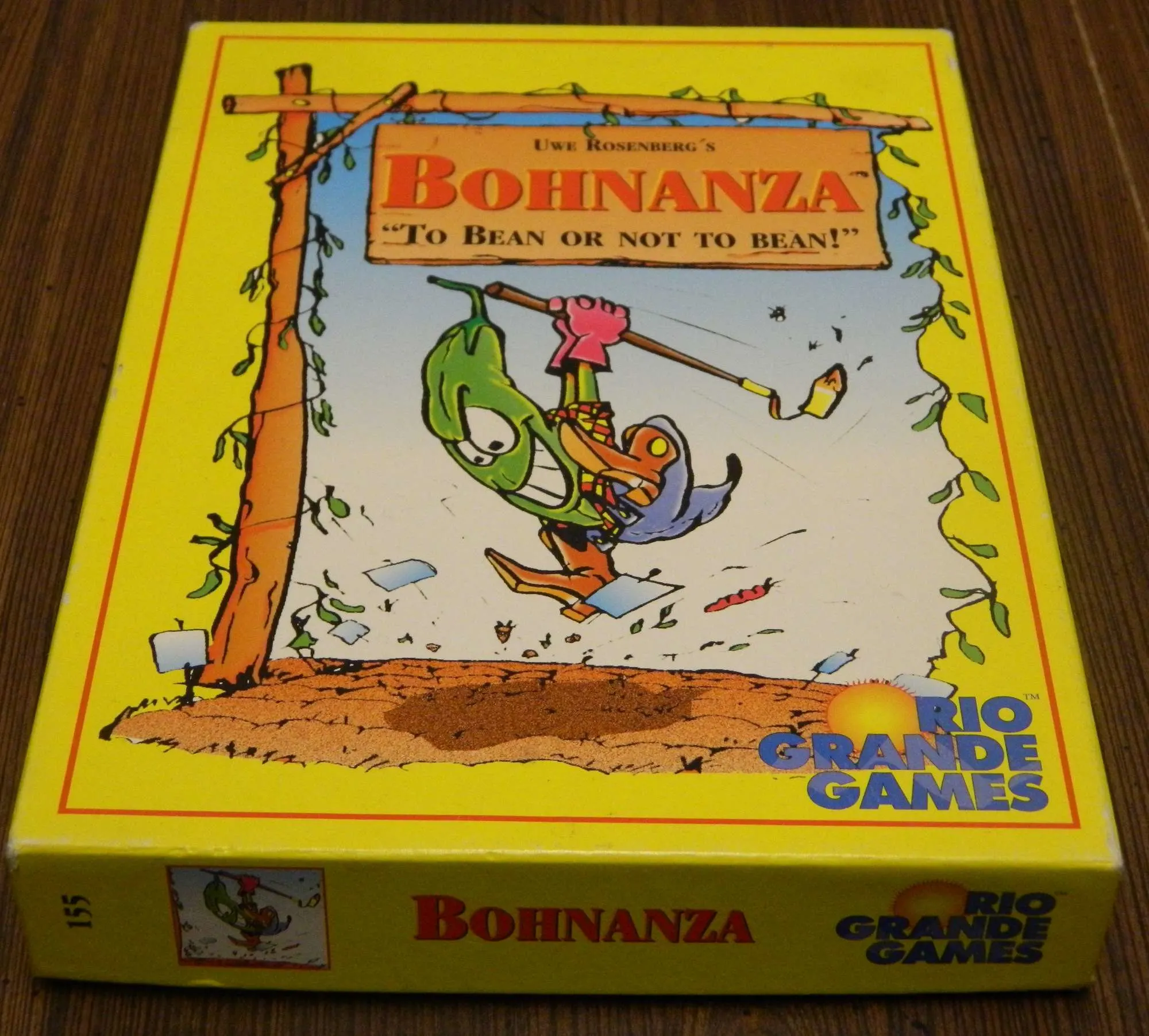
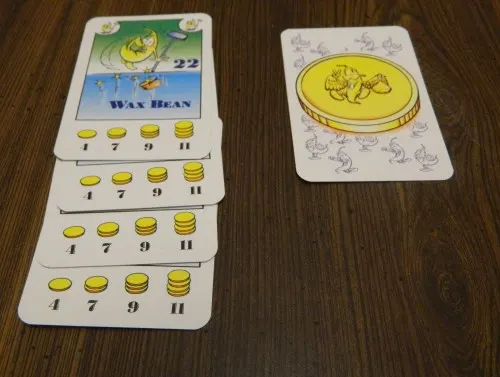
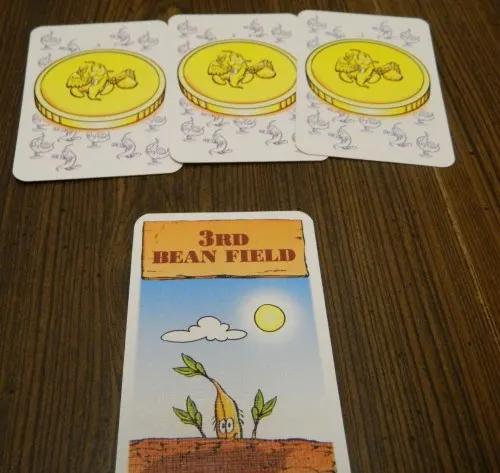
Kora
Wednesday 7th of February 2018
This is years late, but you probably also forgot to take beans out of the supply to match the number of players. Playing with all the bean types would definitely make it difficult to score with the Bean Protection Rule. It would also have contributed to the game length since more beans = more cards => more rounds to get through the deck.
Eric Mortensen
Wednesday 7th of February 2018
I just looked at my rules for the game again and I think this is a case of the rules being changed between different versions of the game. In my version of the game (2000 edition) the normal rules make no mention of removing cards from the game. The only area where this is ever mentioned is in the variant rule sections. I looked at a more recent set of the instructions and those do put a larger emphasis on removing cards from the deck. I am guessing that the publisher decided to further emphasize that you should remove some of the cards from the deck as a lot of players didn't see this option in the variants section.
The next time I play the game I will try playing the game with this rule as I agree that it could probably improve some of the issues that I had with the game. To make other players aware of this rule I have also added a section to the "How to Play" section to point out these additional rules.
Thank you for your comment as it was quite helpful.